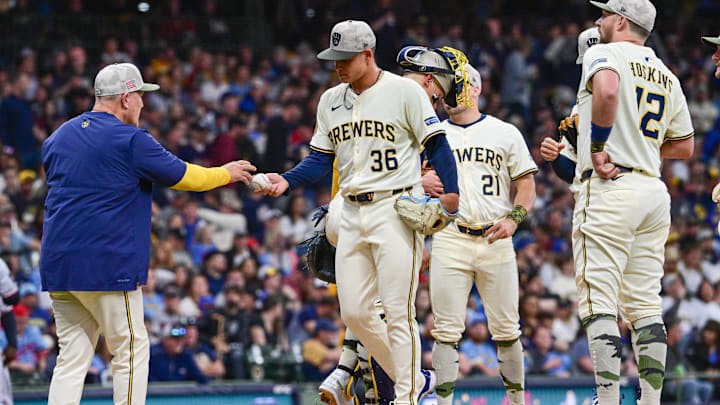At the end of last season, Milwaukee Brewers pitcher Tobias Myers had momentum on his side. He was a breakout pitcher for Milwaukee in 2024, had delivered five innings of shutout baseball in a postseason elimination game, and was one pitcher that manager Pat Murphy had confidently declared as a lock for the starting rotation in 2025.
Unfortunately, baseball had other plans. A spring training oblique strain ended up delaying his '25 MLB debut until the end of April, and struggles ensued afterwards. He walked seven batters altogether during his first six MLB innings, was removed mid-game in order to 'send a message', made one appearance out of the bullpen, and has since bounced around between the major and minor leagues.
This certainly is not the start to the season that anyone expected, and it does raise the question as to what the Brewers’ plans are for him going forward.
The Milwaukee Brewers best plan for Tobias Myers is to continue investing in his development
There are several factors that you can use to explain Myers' step backwards in 2025. He's getting somewhat unlucky on balls in play, as evidenced by his opposing BABIP being up .071 from a season ago. Myers isn't getting the same help from his defense in 2025, as his fielder independent pitching (FIP) number is lower than his ERA after being nearly a run higher in 2024. However, the fact of the matter is that Myers simply isn't locating his pitches the same way he was during his impressive rookie campaign. But that's not to say that he can't find that pinpoint command once again. After all, he's made just five starts in MLB this year — that's essentially one bad month for a starting pitcher.
When it comes to Myers' future, the Brewers’ best approach might be simple: wait and see. We know what the right-hander is capable of when he is firing on all cylinders, and that potential makes him worthy of retaining. If he can return to that level, he could easily become a huge asset for Milwaukee again.
Myers has several factors working in his favor that make it easier for Milwaukee to continue investing in his development. With limited big-league-level experience, one is that he has two more years’ worth of minor league options remaining, indicating that the team has flexibility to use him in the major and minor leagues for a few more seasons, if needed.
Secondly, his pay scale is in pre-arbitration, and he is under team control through the 2030 season. For a small market like Milwaukee, having contributing players in the thousands of dollars yearly range as opposed to the millions works significantly in their favor.
Lastly, it's hard to know what the Brewers' 2026 starting rotation may look like. Nestor Cortes and Aaron Civale are both impending free agents. Freddy Peralta, José Quintana, and Brandon Woodruff all have options for next season, but it's likely only Peralta's will be picked up. Even if Myers doesn't fully figure things out in 2025, there's a real likelihood that he will be needed next year, even with Jacob Misiorowski knocking on the door, Chad Patrick and Logan Henderson playing well this year, and the expected return of Robert Gasser.
Should the Brewers' rotation thin out once more, Myers is a great option to fill in, but with Quintana and Woodruff returning soon, and Henderson and Patrick proving that they are better options in the rotation right now, Myers’ time is best served in Triple-A, honing in his command and continuing to recover from his early-season oblique strain.
Myers is an intriguing talent, and one who’s shown extended flashes of potential, even if they haven’t surfaced this season. Given his roster flexibility, multiple years of team control, and the possibility of significant changes to Milwaukee’s rotation next year, the Brewers have every reason to keep investing in his development.
